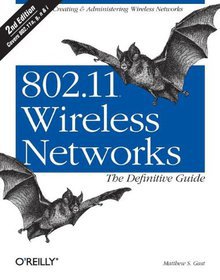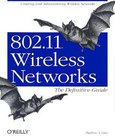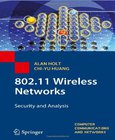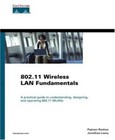802.11 Wireless Networks
The Definitive Guide
2nd Edition

Book Details:
| Publisher: | O'Reilly Media |
| Series: | OReilly , The Definitive Guide |
| Author: | Matthew Gast |
| Edition: | 2 |
| ISBN-10: | 0596100523 |
| ISBN-13: | 9780596100520 |
| Pages: | 672 |
| Published: | May 02 2005 |
| Posted: | Nov 19 2014 |
| Language: | English |
| Book format: | CHM |
| Book size: | 7.48 MB |
Book Description:
As we all know by now, wireless networks offer many advantages over fixed (or wired) networks. Foremost on that list is mobility, since going wireless frees you from the tether of an Ethernet cable at a desk. But that's just the tip of the cable-free iceberg. Wireless networks are also more flexible, faster and easier for you to use, and more affordable to deploy and maintain.The de facto standard for wireless networking is the 802.11 protocol, which includes Wi-Fi (the wireless standard known as 802.11b) and its faster cousin, 802.11g. With easy-to-install 802.11 network hardware available everywhere you turn, the choice seems simple, and many people dive into wireless computing with less thought and planning than they'd give to a wired network. But it's wise to be familiar with both the capabilities and risks associated with the 802.11 protocols. And 802.11 Wireless Networks: The Definitive Guide, 2nd Edition is the perfect place to start.This updated edition covers everything you'll ever need to know about wireless technology. Designed with the system administrator or serious home user in mind, it's a no-nonsense guide for setting up 802.11 on Windows and Linux. Among the wide range of topics covered are discussions on:deployment considerations network monitoring and performance tuning wireless security issues how to use and select access points network monitoring essentials wireless card configuration security issues unique to wireless networks With wireless technology, the advantages to its users are indeed plentiful. Companies no longer have to deal with the hassle and expense of wiring buildings, and households with several computers can avoid fights over who's online. And now, with 802.11 Wireless Networks: The Definitive Guide, 2nd Edition, you can integrate wireless technology into your current infrastructure with the utmost confidence.
Download Link:
Related Books:
802.11 Wireless Networks
The Definitive Guide
As a network administrator, architect, or security professional, you need to understand the capabilities, limitations, and risks associated with integrating wireless LAN technology into your current infrastructure. 802.11 Wireless Networks: The Definitive Guide provides all the information necessary to analyze and deploy wireless networks with confidence.Over the past five years, the world has become increasingly mobile. Traditional ways of networking have altered to accommodate new lifestyles and ways of working. Wireless networks offer several advantages over fixed (or wired) networks, with mobility, flexibility, ease and speed of deployment, and low-cost at the top of the list. Large productivity gains are possible when developers, students, and p...
802.11 Wireless Networks
Security and Analysis
Wireless communication has the advantage of mobility and obviates the need for cabling, but is inherently less secure and is subject to the heavy regulation of the radio frequency spectrum. Nevertheless, the allocation of unlicensed parts of the spectrum has facilitated the growth in wireless local area networks (WLANs). WLAN technology is progressing at a rapid pace, but the most widely accepted WLAN standard is the IEEE 802.11. This unique and highly practical text introduces the principles of WLANs based upon the IEEE 802.11 standards, demonstrating how to configure equipment in order to implement various network solutions. Readers will gain understanding of the security implications of wireless networks and learn how vulnerabilities can be mitiga...
802.11 Wireless LAN Fundamentals
Master the basics in designing, building, and managing a Cisco Aironet WLAN. Master the basics of Wireless LANs with this concise design and deployment guide Understand implementation issues for a variety of environments including vertical, SOHO, and enterprise networks Learn design and troubleshooting advice from real-world case studies 802.11 Wireless LAN Fundamentals gives networking engineers and IT professionals the knowledge they need to design, deploy, manage, and troubleshoot their own wireless local-area networks (WLANs). Starting with an overview of the technology and architecture of WLANs, the book goes on to explain services and advanced features that such applications can provide. Most importantly, it provides practical design guidance ...
2007 - 2021 © eBooks-IT.org



